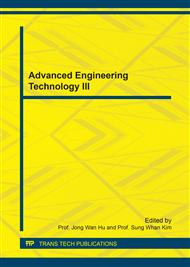[1]
O. Erdinc, M. Uzunoglu, Recent trends in PEM fuel cell powered hybrid systems: investigation of application areas, design architectures and energy management approaches, Renew. Sustain. Energ. Rev. 14(9) (2010) 2874-2884.
DOI: 10.1016/j.rser.2010.07.060
Google Scholar
[2]
J. Speirs, C. McGlade, R. Slade, Uncertainty in the availability of natural resources: Fossil fuels, critical metals and biomass, Energ. Policy 87 (2015) 654-664.
DOI: 10.1016/j.enpol.2015.02.031
Google Scholar
[3]
D. Miljkovic, N. Dalbec, L. Zhang, Estimating dynamics of US demand for major fossil fuels, Energ. Econ. 55 (2016) 284-291.
DOI: 10.1016/j.eneco.2016.02.018
Google Scholar
[4]
B. H. Tsai, C. J. Chang, C. H. Chang, Elucidating the consumption and CO2 emissions of fossil fuels and low-carbon energy in the United States using Lotkae Volterra models, Energ. 100 (2016) 416-424.
DOI: 10.1016/j.energy.2015.12.045
Google Scholar
[5]
M. Sorrentino, C. Pianese, M. Maiorino, An integrated mathematical tool aimed at developing highly performing and cost-effective fuel cell hybrid vehicles, J. Power Sources, 221 (2013) 308-317.
DOI: 10.1016/j.jpowsour.2012.08.001
Google Scholar
[6]
International Energy Agency, The renewable energy 2013: Medium-term market report; A growing role for renewables in the energy mix, International Energy Agency, Paris, (2013).
DOI: 10.1787/9789264191198-en
Google Scholar
[7]
E. E. Petersen, J. Höglund, G. Finnveden, Screening potential social impacts of fossil fuels and biofuels for vehicles, Energ. Policy 73 (2014) 416-426.
DOI: 10.1016/j.enpol.2014.05.034
Google Scholar
[8]
R. Castellano, R. Cerqueti, L. Spinesi, Sustainable management of fossil fuels: A dynamic stochastic optimization approach with jump-diffusion, Eur. J. Oper. Res.
DOI: 10.1016/j.ejor.2016.04.052
Google Scholar
[9]
R. Sathre, Comparing the heat of combustion of fossil fuels to the heat accumulated by their lifecycle greenhouse gases, Fuel, 115 (2014) 674-677.
DOI: 10.1016/j.fuel.2013.07.069
Google Scholar
[10]
O. Paish, Small hydro power: technology and current status, Renew. Sust. Energ. Rev. 6 (2002) 537–556.
Google Scholar
[11]
G. A. Zohbi, P. Hendrick, C. Renier, P. Bouillard, The contribution of wind-hydro pumped storage systems in meeting Lebanon's electricity demand, Int. J. Hydro. Energ. 41 (2016) 6996–7004.
DOI: 10.1016/j.ijhydene.2016.01.028
Google Scholar
[12]
E. Barbour, I. A. G. Wilson, J. Radcliffe, Y. Ding, Y. Li, A review of pumped hydro energy storage development in significant international electricity markets, Renew. Sust. Energ. Rev. 61 (2016) 421–432.
DOI: 10.1016/j.rser.2016.04.019
Google Scholar
[13]
M. M. A. Bhutta, N. Hayat, A. U. Farooq, Z. Ali, S. R. Jamil, Z. Hussain, Vertical axis wind turbine- a review of various configurations and design techniques, Renew. Sust. Energ. Rev. 16 (2012) 1926–(1939).
DOI: 10.1016/j.rser.2011.12.004
Google Scholar
[14]
J. Xu, L. Li, B. Zheng, Wind energy generation technological paradigm diffusion, Renew. Sust. Energ. Rev. 59 (2016) 436–449.
DOI: 10.1016/j.rser.2015.12.271
Google Scholar
[15]
J. Wang, J. Hu, K. Ma, Wind speed probability distribution estimation and wind energy assessment, Renew. Sust. Energ. Rev. 60 (2016) 881–899.
DOI: 10.1016/j.rser.2016.01.057
Google Scholar
[16]
K. H. Solangiv, M. R. Islam, R. Saidur, N. A. Rahim, H. Fayaz, A review on global solar energy policy, Renew. Sust. Energ. Rev. 15 (2011) 2149–2163.
DOI: 10.1016/j.rser.2011.01.007
Google Scholar
[17]
P. Atkin, M. M. Farid, Improving the efficiency of photovoltaic cells using PCM infused graphite and aluminium fins, Solar Energ. 114 (2015) 217–228.
DOI: 10.1016/j.solener.2015.01.037
Google Scholar
[18]
A. A. Ogedengbe, H. Hangan, K. Siddiqui, Experimental investigation of wind effects on a standalone photovoltaic (PV) module, Renew. Energ. 78 (2015) 657–665.
DOI: 10.1016/j.renene.2015.01.037
Google Scholar
[19]
M. Mofijur, H. H. Masjuki, M. A. Kalam, Palm oil methyl ester and its emulsions effect on lubricant performance and engine components wear, Energ. Procedia 14 (2012) 1748-1753.
DOI: 10.1016/j.egypro.2011.12.1162
Google Scholar
[20]
D. Liuzzi, F. J. P. Alonsoa, J. L. G. Fierro, S. Rojas, F. L. V. Wijk, I. Roghair, M. V. S. Annaland, E. Fernandez, J. L. Viviente, D. A. P. Tanaka, Catalytic membrane reactor for the production of biofuels, Catal. Today 268 (2016) 37-45.
DOI: 10.1016/j.cattod.2015.11.014
Google Scholar
[21]
J. Remón, P. A. Arrillaga, L. García, J. Arauzo, Production of gaseous and liquid bio-fuels from the upgrading of lignocellulosic bio-oil in sub- and supercritical water: Effect of operating conditions on the process, Energ. Convers. Manage. 119 (2016).
DOI: 10.1016/j.enconman.2016.04.010
Google Scholar
[22]
U. Sadi, A. T. Wijayanta, M. Goto, N. Kamiya, Great potency of seaweed waste biomass from the carrageenan industry for bioethanol production by peracetic acid-ionic liquid pretreatment, Biom. Bioenerg. 81 (2015) 63-69.
DOI: 10.1016/j.biombioe.2015.05.023
Google Scholar
[23]
E. N. Manolis, T. D. Zagas, C. A. Poravou, D. T. Zagas, Biomass assessment for sustainable bioenergy utilization in a Mediterranean forest ecosystem in northwest Greece, Ecol. Eng. 91 (2016) 537-544.
DOI: 10.1016/j.ecoleng.2016.02.041
Google Scholar
[24]
G. M. J. Herbert, A. U. Krishnan, Quantifying environmental performance of biomass energy, Renew. Sust. Energ. Rev. 59 (2016) 292–308.
Google Scholar
[25]
S. M. Schoenung, W. V. Hassenzahl, Long-vs short-term energy storage technologies analysis: A life-cycle cost study; A study for the DOE energy storage systems program, United Nations, Santiago, (2003).
DOI: 10.2172/918358
Google Scholar
[26]
O. A. Alvarez-Silva, A. F. Osorio, C. Winter, Practical global salinity gradient energy potential, Renew. Sust. Energ. Rev. 60 (2016) 1387–1395.
DOI: 10.1016/j.rser.2016.03.021
Google Scholar
[27]
M. A. Mujeebu, O. S. Alshamrani, Prospects of energy conservation and management in buildings-The Saudi Arabian scenario versus global trends, Renew. Sust. Energ. Rev. 58 (2016) 1647–1663.
DOI: 10.1016/j.rser.2015.12.327
Google Scholar
[28]
J. Khedari, A. Sangprajak, J. Hirunlabh, Thailand climatic zones, J. Renew. Energ. 25 (2001) 267-280.
DOI: 10.1016/s0960-1481(01)00005-2
Google Scholar
[29]
The development of renewable energy and energy conservation. (July 14, 2006). Solar Technology. Retrieved Fabuary14, 2014, fromhttp: /www. stasolar. org/SUNTECH/sun_tech. htm.
Google Scholar
[30]
A. Thongtha, S. Maneewan, C. Punlek, Y. Ungkoon, Investigation of the compressive strength, time lags and decrement factors of AAC-lightweight concrete containing sugar sediment waste, Energ. Build. 84 (2014) 516-525.
DOI: 10.1016/j.enbuild.2014.08.026
Google Scholar


